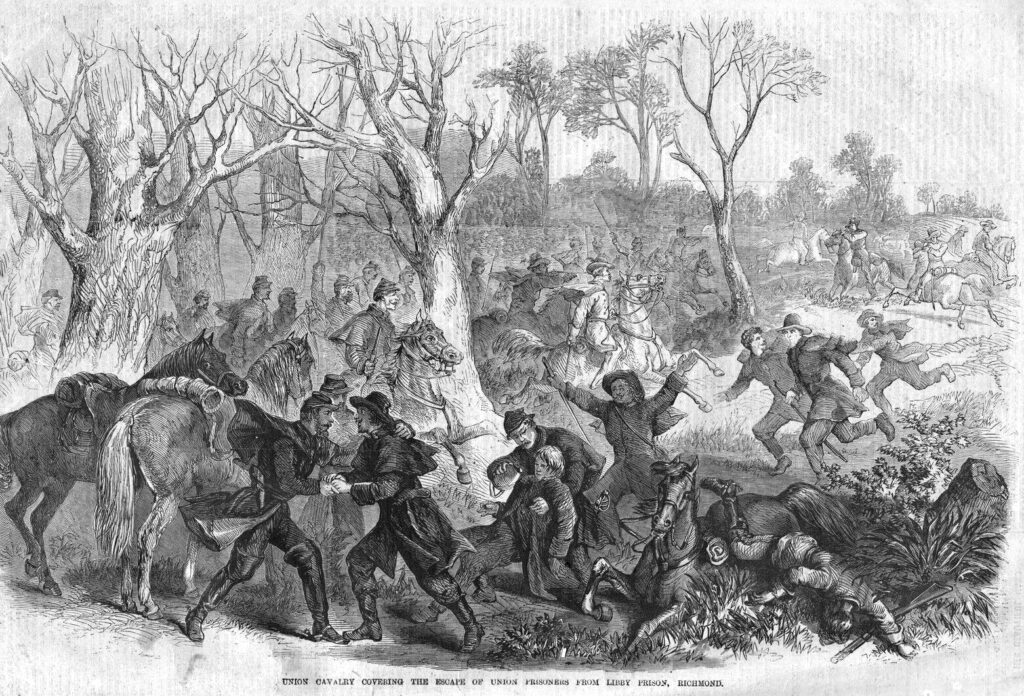On February 9, 1864, more than 100 Union prisoners tunneled their way to freedom in an audacious escape from Libby Prison in the Confederate capital of Richmond, Virginia. More than half of the prisoners made their way to Union lines while others were recaptured and returned to the confines of Libby.
Libby Prison started as an old food warehouse on Tobacco Row along the James River.
Captain Luther Libby, along with his son George W. Libby, leased the three-story brick building where they operated a ship chandlery and grocery business. In 1862, the Confederacy took over the building and turned it into a prison for Union officers. Colonel Thomas E. Rose, a Union officer from the 77th Pennsylvania Volunteer Infantry, was captured during the Battle of Chickamauga and taken to Libby Prison. He found conditions appalling and immediately started plotting his escape. He devised an ambitious plan to dig a tunnel from the cellar of the prison to a tobacco shed that stood just outside the prison walls.

Rose revealed his plan to a few trusted accomplices and planning got underway. Life inside Libby Prison was miserable. Prisoners were held on the second and third floors of the building. Windows were barred but open, leaving inmates freezing in the winter and insufferably hot in summer. Overcrowding created constant stress and resulted in 2 food shortages. The lack of sanitation led to disease and death. One father whose son was held at Libby prison desperately sought to have supplies delivered to the prison.

He wrote, “He has been confined during the whole summer without a change of clothing, and is in a very destitute condition.” Desperate for relief, it was not difficult for Rose to find prisoners willing to help with his plot.
Outside of Libby was a canal, and during wet weather, the prison’s cellar flooded bringing hundreds of rats scurrying into the building. The putrid air in the cellar kept everyone away and helped it earn the nickname, Rat’s Hell. The area was largely avoided by Confederate guards and provided Rose and his associates the perfect place to dig undetected.

Rose accessed Rat’s Hell by removing bricks behind an old kitchen stove. He then shimmied down a chimney to the cellar. From there, Rose and his team scraped away at the hard dirt using crude makeshift tools. Much of the digging took place at night in the dark when the exterior was heavily guarded, but conditions inside the prison were somewhat relaxed.
Loads of earth were removed one bucket at a time, by packing an old spittoon with excavated dirt. The vermin-infested cellar, the rats, and the lack of oxygen made the work excruciating. At one point, after digging a tunnel nearly 60 feet long, the prisoners broke through the surface to find they were off by several feet. Hearing the voices of Confederate guards, the prisoners quickly hid the tunnel and readjusted the approach to the shed.
How Did the Prisoner Describe the Escape from Libby Prison?
After weeks of digging, the prisoners managed to clear a tunnel that surfaced in the tobacco shed. One prisoner described the escape from Libby prison, “Everyone wanted to be first. In order to get down the chimney as well as long the tunnel, it was necessary to strip naked, wrap the clothes in a bundle and push this on before them. As soon as it was seen that only a few could possibly get out before daylight, all rushed for the mouth of the tunnel who could – each man being determined to get out first. The room was now crowded to suffocation all struggling to get in the hole. The strongest men forced their way to the front while the weak ones were more roughly brushed aside and jammed up against the walls.”
The next morning at roll call, Confederate guards were shocked to find 109 prisoners missing, their escape route concealed by the remaining inmates. Of those 109 prisoners that escaped, 59 eventually reached Union lines, 48 were recaptured and two drowned in a river crossing.
Read About Other Military Myths and Legends
If you enjoyed learning about escape from Libby Prison, we invite you to read about other military myths and legends on our blog. You will also find military book reviews, veterans’ service reflections, famous military units and more on the TogetherWeServed.com blog. If you are a veteran, find your military buddies, view historic boot camp photos, build a printable military service plaque, and more on TogetherWeServed.com today.

Very good reading for a history buff! Shows the brain power and physical strength of man that has follow him thru the history of America.
My great great grandfather was a confederate and was captured and sent to The yankee prison camp Rock Island, ill. He never had the opportunity to escape because he died of disease and is buried there. All these prison camps,North and South were shit holes and many perished!
Thats not a good map of tunnel or of that block